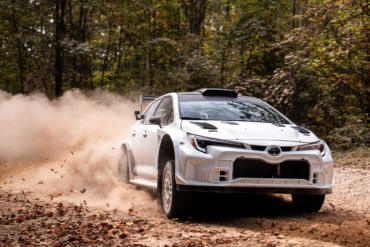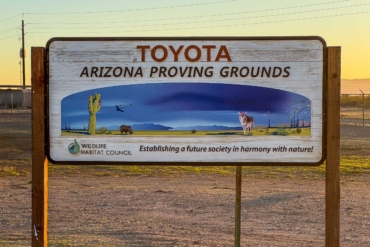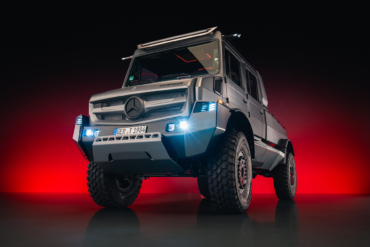The hybrid of Toyota’s established Land Cruiser and camp-savvy Trekker, the iconic 4Runner may be the most enduring adventure SUV in U.S. history.
It was the early 1980s. The place? A humble little city named Brookfield, Wisc. It was there that the idea for the Toyota 4Runner (a portmanteau of “four-wheel drive” and “off-road runner”) was born. See, sales of the 4Runner’s larger predecessor, the Land Cruiser, were soon ending in the United States.
The Land Cruiser’s exit would leave a significant gap in the American utility vehicle market. Folks would need something to get them over gravel-heavy backroads and up steep mountain terrain. But they’d also want something well suited to more domestic endeavors.
In 1981, Toyota and Winnebago rolled out the Trekker, which consisted of a camper shell modification to the Hilux pickup. The Trekker set a precedent for Toyota — it was now the most agile and capable maker of affordable off-road vehicles.
Enter the Toyota 4Runner

And in 1984, the 4Runner was born — a compact, all-terrain rig capable of so much. And since that time, Toyota has rolled out a litany of enhancements.
From the OG removable hardtop design to the beach-bum-friendly Baja to today’s high-octane TRD Pro and Trail models, the 4Runner has consistently ranked among the bestselling adventure rigs.
Significant Evolutions in 4Runner Design
1984-1989

Released in 1984, the first-gen 4Runner was really just a two-seater pickup complete with a removable fiberglass roof for the rear cargo bay and 4WD. It was durable and simple — the ideal rig for gear-toting drivers.
A new, five-passenger model, the SR5 followed in 1985 and incorporated a fold-down, three-seater bench in back.
The 1986 4Runner boasted higher grounder clearance and a smoother ride thanks to Toyota’s Hi-Trac indy front suspension. And a turbocharged engine became available in the SR5 models.
In 1988, Toyota replaced the turbo engine with a 3.0L V6, which better served the SUV’s off-road purposes.
1990-1999

For the 1990 model year, Toyota released a fully redesigned 4Runner. The new iteration borrowed heavily from Toyota’s truck line: buyers could choose from the two- or four-door configurations, four- or six-cylinder engines, and either 2WD or 4WD.
The removable fiberglass truck bed top was no more, replaced with the SUV’s integrated hatchback design. The update dampened external sounds and made the cabin significantly more weatherproof.
In 1994, safety and media ruled. The 4Runner now included side-impact protection, a third brake light, and optional four-wheel antilock brakes (V6 models only). The fully-optioned models came with a built-in CD player and eight-speaker array, sunroof, and leather upholstery.

For 1996, the SUVs received new engine options — a 2.7L four-cylinder and 3.4L V6 –, a more stable chassis, double-wishbone spring suspension up front, and the now iconic lift-up hatch with its rear power window.
As for safety features, 1996 was also the first year that dual airbags, four-wheel ABS, side-door impact beams, and auto-locking/emergency locking seatbelts became standard.
The 1999 4Runner Limited received a new multi-mode 4WD system with 2WD capability.
2000-2009

For 2001, multi-mode 4WD, a 2WD/4WD selector, 3.4L V6 engine, Vehicle Skid Control, and a pre-wired hitch harness became standard throughout the range. This was also the year that Toyota shifted to hydraulic-assisted braking and discontinued the rear differential lock.
2003 marked a new era for the 4Runner in terms of design and technological advancements. A larger build, roomier interior, increased power, and more efficient fuel consumption were front-and-center.
Under the hood, Toyota provided all-new 4.0L V6 aluminum engines which boasted 245 horsepower at 5,200 rpm, with 283 lb.-ft. torque at 3,400 rpm. Drivers also had a new 4.7L i-Force V8 option that could put out 235 horsepower at 4,800 rpm and 320 lb.-ft. of torque at 3,400 rpm.
The 2003 4Runner was also the first mid-size SUV to house a Torsen torque-sensing limited-slip center differential.
In 2004, the automaker added a backup camera to the vehicle’s nav system. An optional third-row seat became available for Limited and SR5 trims.

For 2009, Toyota rolled out two new packages: the Trail Edition and the Urban Runner.
The Trail Edition 4Runner reintroduced Toyota’s rear-locking differential and debuted Active Traction Control, Bilstein shock absorbers, and 16-inch alloy wheels. Tubular side steps and a tubular roof rack added to the vehicle’s utility, and water-resistant seating was standard.
The Urban Runner trim was available only on Sport models. The luxury-angled package offered 18-inch alloy wheels, a color-keyed grille, a chrome exhaust tip, and a tubular side step/roof rack system akin to that of the Trail Edition. Oh — as well as a rear spoiler, because why the hell not.
The Urban grades also leveled up on infotainment. An integrated but portable TomTom navigator, six-speaker sound system, Bluetooth compatibility, and WMA/MP3 playability decked out the model’s tech setup.
2010-2022

The fifth-generation SUV came out in 2010 and offered stylistic upgrades. Often described as a leaner, more rugged iteration, the 2005 models combined improved power, mileage, and a hyper-versatile cargo system.
In 2011, brake override technology became standard on all models.
And in 2012, the 4Runner SR5 and Limited models offered automatic running boards. Toyota also set up its new SR5 and Trail 4Runners with standard XM radio capability, USB ports, iPod connectivity, and a hands-free Bluetooth dash system for safer call handling and streaming.

Per Toyota, today’s 4Runner SR5 and SR5 Premium models “combine the comfort of an urban SUV with the ability to venture onto the trails.”
The TRD Sport adds X-REAS Sport Enhancement Suspension for even more challenging terrain. The Trail Special Edition ups the adventure factor with a cargo basket and removable 40-quart cooler.
And, “for off-road fanatics,” Toyota offers up the TRD Off-Road and Off-Road Premium. Both models boast Crawl Control (CRAWL) and a locking rear differential.
Drivers can also opt for the luxury on-road focused Limited trim for dual-zone climate control and leather-trimmed seats.

And, rounding out the current array of 4Runners is the TRD Pro. The TRD Pro comes with TRD FOX high-performance shocks and TRD-tuned front springs.
But no matter the upgrades, the off-road vehicle retains the same principles that made it so popular 38 years ago. To borrow from the brand’s senior vehicle planning analyst, Ryan Bray: “Produce something that works well the first time, then continue to improve and perfect it.”

For more information on the 4Runner’s history, options, and where Toyota plans to take its bestselling SUV, head to Toyota.com.








